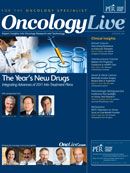Publication
Article
Radium-223 Properties Conducive to mCRPC Care
Author(s):
Radium-223, an alpha-emitting radiopharmaceutical, has been shown to improve overall survival (OS) in men with metastatic castrationresistant prostate cancer (mCRPC) in an interim analysis of the ALSYMPCA trial.

Oliver Sartor, MD
Radium-223, an alpha-emitting radiopharmaceutical, has been shown to improve overall survival (OS) in men with metastatic castrationresistant prostate cancer (mCRPC) in an interim analysis of the ALSYMPCA trial.
This is the sixth treatment that has shown improved OS in mCRPC, and as such, expands the growing armamentarium for this disease. The 6 treatments are docetaxel/prednisone, sipuleucel-T (Provenge), cabazitaxel (Jevtana)/prednisone, abiraterone (Zytiga)/ prednisone, MDV3100, and radium-223 (Alpharadin).
“We have a whole variety of agents that prolong survival, and we need to learn how to sequence them,” said Oliver Sartor, MD, medical director of the Tulane Cancer Center in New Orleans, Louisiana.
At the Chemotherapy Foundation Symposium in November, Sartor told attendees about the special properties of the alphaemitting radiopharmaceutical radium-223 and the positive findings of the first interim analysis of the recent prospective, randomized, placebo-controlled ALSYMPCA trial in mCRPC.
Marie and Pierre Curie isolated radium more than 110 years ago and won the Nobel Prize for this discovery in 1903. “The cancer activity of radium was immediately recognized. There are not a lot of drugs for cancer that we’ve been using for more than 100 years,” Sartor observed.
Radium acts as a calcium mimetic, and it homes to the bone, binding to osteoclast cells with preferential uptake in areas of new bone formation. Compared with beta-emitting radiopharmaceuticals, radium-223 gives off a huge amount of energy and travels over a short range.
“It takes far fewer hits to kill a cell with an alpha-emitter than a beta-emitter. Radium-223 is short range but deadly, with a highly localized effect,” Sartor explained.
Phase I and phase II trials showed that radium-223 was well tolerated, had uptake in imaging of the bone, provided pain relief, and caused minimal myelosuppression. A randomized phase II trial found that radium-223 improved overall survival by 52%, which led to the phase III ALSYMPCA trial.
ALSYMPCA randomized men with 2 or more bone metastases (no known visceral metastasis) 2:1 to receive radium-223 or placebo. Radium-223 was administered in up to 6 injections at 4-week intervals. All men were treated with secondary hormones, and planned follow-up was 3 years.

At the planned interim analysis, the benefit in favor of radium-223 was so clear that the trial was halted prematurely, and men in the placebo group were allowed to cross over to the active treatment.
Overall survival was 11.2 months in the placebo group versus 14 months in the radium-223 group (P =.00185); time to first skeletal-related event was 8.4 months for placebo versus 13.6 months for radium-223 (P =.00046). Radium-223 was significantly superior for all secondary endpoints, Sartor said.
Yet these results were achieved with hardly any cost in terms of adverse events. The frequency of adverse events was higher in the placebo arm. Discontinuation rates were 20% for placebo and 13% for radium-223.
“That’s the mark of a good drug,” Sartor commented.
Grade 3/4 neutropenia was 2% in the radium-223 arm, grade 3/4 thrombocytopenia was 4% in that arm, and all grades of neutropenia were 4%.
“This drug hardly touches the bone marrow,” Sartor said.
He told the attendees that radium-223 should be considered a new standard of care for mCRPC. Bayer HealthCare Pharmaceuticals Inc, which is developing the drug, plans to file a new drug application with the FDA by mid-2012.
Now that there are so many good choices to treat mCRPC, studies will be needed to figure out how best to combine and sequence them. In the current healthcare environment, cost is an important consideration, however.
“We also need to figure out how we are going to afford this,” Sartor stated.










